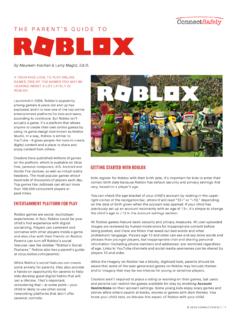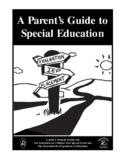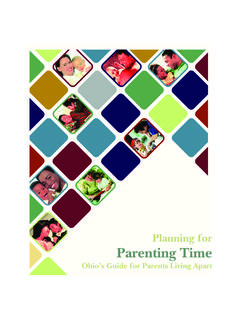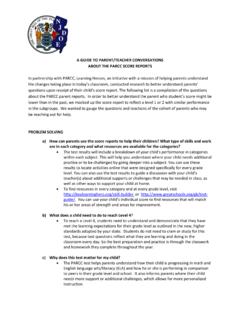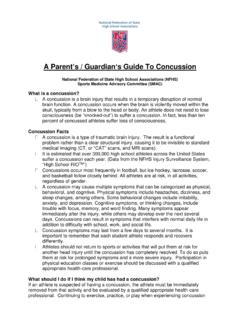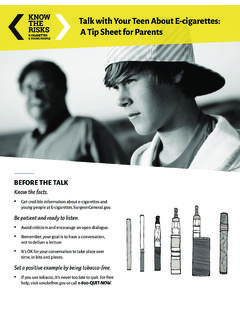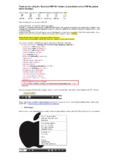Transcription of TRAINING GUIDE FOR PARENTS, TEACHERS AND STUDENT …
1 TRAINING GUIDE FOR parents , TEACHERS AND STUDENT LEADERS. WASH-FRIENDLY SCHOOLS. 2010. This publication was produced for the United States Agency for International Development. It was prepared by the USAID Hygiene Improvement Project through AED. The USAID Hygiene Improvement Project (HIP) is a six-year (2004-2010) project funded by the USAID Bureau for Global Health, Office of Health, Infectious Diseases and Nutrition, led by the Academy for Educational Development (contract # GHS-I-00-04-00024-00) in partnership with ARD Inc., the IRC International Water and Sanitation Centre, and the Manoff Group. HIP aims to reduce diarrheal disease prevalence through the promotion of key hygiene improvement practices, such as hand washing with soap, safe disposal of feces, and safe storage and treatment of drinking water at the household level.
2 USAID Hygiene Improvement Project Academy for Educational Development 1825 Connecticut Avenue, NW. Washington, DC 20009-5721. Tel. 202-884-8000; Fax: 202-884-8454. - August 2010. WASH Friendly Schools TRAINING GUIDE 2 Table of Contents Acknowledgements .. 5. Introduction .. 6. Enabling Environment for WASH-Friendly Schools .. 8. How to Use This GUIDE .. 9. Objectives and Schedule .. 11. Objectives of the TRAINING .. 11. Workshop Schedule 12. Session 1: Introduction to the TRAINING .. 13. 1. a Who Are We? .. 13. 1. b Why Are We Here? .. 13. 1. c What Are We Going to Do? .. 13. Session 2: Discovering the Hygiene, Water, and Sanitation Situation in Our School .. 15. 2. a Why Are Clean Drinking Water, Using Latrines, and Washing Hands Important? .. 15. 2 b School Ignition: Walkabout for Discovery, Reaction, 16.
3 Session 3: Understanding the WASH Problem How Bad Is It? .. 20. 3. a Shit/Feces Calculation .. 17. 3. b Results of WASH Surveys .. 20. 3. c Consequences of Feces Contamination and Poor WASH Infrastructure and Poor Hygiene Practices .. 23. 3. d Wrap-up of the 24. Session 4: What Can We Do about the WASH Problem? .. 25. 4. a The F Routes of Feces Contamination and How to Block Them .. 25. Session 5: Three Critical WASH Practices Hand Washing with Soap .. 30. 5. a Overview of Three Key Practices and Simple Techniques (Tippy Taps, SODIS).. 31. 5. b Why Hand Washing Is Important .. 32. 5. c How to Wash Hands Correctly (Demonstration) .. 33. 5. d How to Make a Water-Saving Hand Washing 34. Session 6: Three Critical WASH Practices Making Drinking Water Safe from Source to Mouth.
4 38. 6. a Water Safety Chain .. 38. 6. b Pros and Cons of Different Water Treatment Methods .. 41. 6. c Demonstration SODIS Method of Purifying Water .. 42. 6. d SODIS in School Calculation Exercise .. 42. Session 7: Three Critical WASH Practices Using Hygienic Latrines .. 45. WASH Friendly Schools TRAINING GUIDE 3 Session 8: How to Make Our School WASH-Friendly .. 49. 8. a Introduction to Elements of a WASH-Friendly School .. 49. 8. b Planning for Making Our School WASH-Friendly .. 51. Session 9: Wrap Up, Pledges, and Next Steps .. 54. Session 10: Supplementary Half-Day TRAINING Session for TEACHERS Only .. 55. 10. a Integrating WASH Themes into Classroom Teaching .. 55. 10. b WASH School Clubs .. 56. 10. c Action Planning .. 57. 10. d Wrap Up .. 57. WASH Friendly Schools TRAINING GUIDE 4 Acknowledgements This document has evolved from experiences in Madagascar and Ethiopia, countries where the Hygiene Improvement Project has had at-scale programs.
5 HIP is especially indebted to the entire WASH-Friendly Schools (Ecoles Amies de WASH) team in Madagascar that first developed a GUIDE , including the ministries in charge of education, health and water, UNICEF, HIP/Madagascar, WaterAid, Office National pour la Nutrition, many regional and district level school officials and dedicated TEACHERS . In Ethiopia, HIP was able to pilot this TRAINING GUIDE as part of its Community-led Total Behavior Change in Hygiene and Sanitation Program in the Amhara region, with the World Bank's Water and Sanitation Program and the Amhara Bureaus of Health and Education. Feedback from regional, zonal and district administration and WASH officials, trainers, TEACHERS , parents and youth leaders helped to strengthen and improve the TRAINING GUIDE and adapt it to another African context quite diverse from Madagascar.
6 Additional thanks to HIP's partners, IRC International Water and Sanitation Centre and The Manoff Group, for reviewing drafts of this TRAINING GUIDE and the accompanying WASH- Friendly Schools Basic GUIDE for Directors, TEACHERS , Students, parents , and Administrators. WASH Friendly Schools TRAINING GUIDE 5 Introduction The WASH (water, sanitation, and hygiene) in Schools movement is gaining momentum, evidenced by an increase in international and local attention and funding, the development of school-based resources, and implementation designs for schools all over the world, including a Call to Action for WASH in Schools, launched in April The objective is to create and maintain WASH-Friendly Schools that have safe and healthy environments, including adequate hygiene and sanitation facilities that allow children to be healthier, more attentive learners.
7 Since it is estimated that fewer than half of the schools in the world have access to drinking water, and even fewer have access to adequate sanitation, this situation has become critical. USAID's Hygiene Improvement Project (HIP) model for WASH-Friendly Schools has emerged from experiences in Madagascar and Ethiopia where HIP has worked with various government and NGO partners to integrate hygiene improvement into the education sector. The first iteration of the approach in Madagascar was based on a model promoted by UNICEF, which HIP enhanced by introducing the concept of small doable actions . breaking down the three key WASH practices (washing hands with soap, drinking clean water, using improved sanitation facilities) into doable steps and asking that households, schools, and health centers try to incorporate these steps at a feasible pace to eventually become WASH-friendly.
8 HIP worked closely with the Ministry of Education, UNICEF, WaterAid, and others to develop a GUIDE and support a national program to put into practice the Madagascar WASH-friendly schools model. In Ethiopia, HIP worked through the Ministry of Health and the Regional Bureaus of Health and Education in the Amhara Region, in partnership with the Water and Sanitation Program (WSP) of the World Bank, to bring community-led total behavior change in hygiene and sanitation to the Amhara Region. The total strategy includes WASH-friendly schools as part of any community's hygiene and sanitation improvement approach. Two key elements of the broader approach promoting improved hygiene and sanitation behaviors through small doable actions and the methodology and tools of the Community-Led Total Sanitation (CLTS) approach were adapted for schools, much like the SLTS (School-Led Total Sanitation) approach developed in Nepal.
9 Commitment for WASH-friendly schools was forged at the district level, and then district officials, development partners, parents , and educators rolled out the approach throughout the region, each doing their part to achieve WASH-friendly status. Using the WASH-Friendly Schools TRAINING GUIDE for parents , TEACHERS and School Leaders, groups of TEACHERS , parents , and STUDENT leaders were trained in the issues and methodology and guided to develop coordinated action plans that specify the 1. A Call to Action for WASH in Schools was launched at the Dubai International Humanitarian Aid Conference, April 5, 2010, by CARE, Dubai Cares, UNICEF, World Health Organization (WHO), Save the Children, and other key partners. WASH Friendly Schools TRAINING GUIDE 6 implementation roles of government, parents , TEACHERS , students, and others.
10 They then returned to their respective schools and communities to implement the 13 steps necessary for creating a WASH-Friendly School. The material related to total community sanitation and hygiene comes from the Woreda Resource Book for Total Hygiene and Sanitation2 produced by HIP for the Amhara Region in Ethiopia. Other pieces are adapted from the WASH- friendly schools GUIDE developed in Madagascar with HIP assistance. The present TRAINING GUIDE and the companion WASH-Friendly Schools Basic GUIDE for Schools Directors, TEACHERS , Students, parents and Administrators are now a tested package that HIP has adapted from country-specific models for use in schools, communities, governments, and organizations anywhere. As with all such endeavors, these two guides should be adapted and refined to be as useful as possible in different settings.
